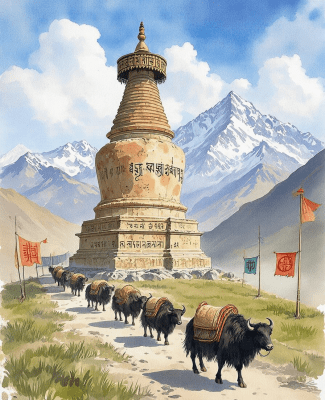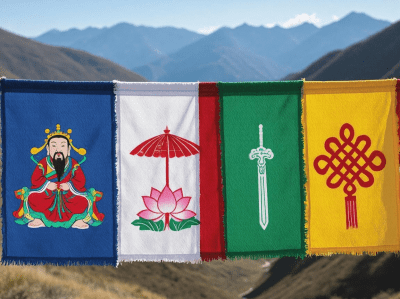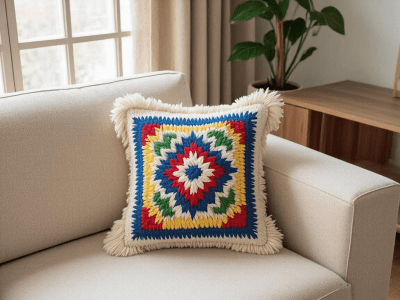Prayers on the Wind: The Story of Tibet’s Fluttering Prayer Flags

High on the roof of the world, where the air thins and the horizon stretches forever, a breathtaking sight unfolds: rivers of color cascading down mountainsides, dancing wildly from bridges, crowning monasteries, and whispering secrets from humble homes. These are Tibetan Prayer Flags, known locally as Lung ta (Wind Horse) flags. More than mere decoration, they are silent yet eloquent prayers carried on the breath of the wind, an ancient practice deeply woven into the spiritual and cultural tapestry of the Tibetan Plateau for well over a millennium. Their fluttering presence is a universal language of hope, protection, and connection. Let’s unravel their profound symbolism.
Chapter 1: Whispers on the Silk Road – A Blend of Traditions (c. 7th-11th Century CE)

The origins of prayer flags are beautifully complex, reflecting the crossroads nature of Tibet. They likely emerged from the interaction of indigenous Bon traditions – which revered nature spirits (Lu and Nyen) dwelling in mountains, rivers, and trees – with Buddhist teachings arriving from India along the Silk Road.
-
Bon Roots: Pre-Buddhist Bon rituals involved hanging cloth talismans (lhadar) featuring animal figures (particularly the wild, untamed yak) and potent symbols. These were offerings to appease and honor powerful local deities, seeking protection for travelers and livestock traversing the treacherous landscapes, and blessings for health and good fortune.
-
Buddhist Integration: With the arrival of Buddhism (especially Vajrayana or Tantric Buddhism), the purpose evolved. The concept of sending prayers outward via the wind became central. Figures evolved from animals to sacred Buddhist symbols and written mantras (sacred syllables). The ”Wind Horse” (Lung ta) became a key symbol – a horse carrying the Wish-Fulfilling Jewel (Chintamani) on its back, galloping across the sky, symbolizing the rapid fulfillment of positive wishes and the spread of good fortune on the wind.
This fascinating fusion created a unique tradition: physical prayers harnessed to the elemental power of wind.
Chapter 2: The Five-Fold Wisdom – Meaning in Every Hue and Symbol

The most iconic feature is the sequence of five colors, always arranged in a specific order from left to right:
-
Blue (Nam mka’ – Sky): Representing Space / Sky / The Vast. The boundless expanse, the ultimate nature of reality. Associated with the Buddha Akshobhya and the transmutation of anger into wisdom.
-
White (Dkar po – Clouds): Representing Air / Wind / Purity. The element that carries prayers, wisdom, and healing. Associated with the Buddha Vairocana and the transmutation of ignorance into wisdom.
-
Red (Dmar po – Fire): Representing Fire / Energy / Life Force. Passion, warmth, magnetizing activity, and compassionate power. Associated with the Buddha Amitabha and transforming attachment into discernment.
-
Green (Ljang gu – Water): Representing Water / Harmony / Growth. Life, vitality, balance, accomplishment of activity, and protection from obstacles. Associated with the Buddha Amoghasiddhi and transmuting jealousy into accomplishment.
-
Yellow (Ser po – Earth): Representing Earth / Stability / Grounding. Foundation, generosity, abundance, and rootedness. Associated with the Buddha Ratnasambhava and transforming pride into equanimity.
More Than Color:
-
Lung ta (Wind Horse): The central figure, usually depicted on the white flag, symbolizing life force, positive energy, and the swift fulfillment of good wishes carried aloft.
-
Sacred Mantras: Common inscriptions include the universal Mani mantra “Om Mani Padme Hum” (Hail to the Jewel in the Lotus), invoking compassion, or ”Om Ah Hum” representing body, speech, and mind, blessing the surroundings.
-
Symbols: The Four Dignities (Four Harmonious Friends – Elephant, Monkey, Rabbit, Bird), representing harmony; the Eight Auspicious Symbols (Ashtamangala), each signifying different aspects of the enlightened path (Parasol, Golden Fishes, Treasure Vase, Lotus, Conch Shell, Endless Knot, Victory Banner, Dharma Wheel); Guardian Deities, offering protection.
Chapter 3: Blessings on the Breeze – Meaning, Making, and Placement

Why Flutter? Central to the practice is the belief that the wind activates the prayers and mantras printed on the cloth. Each flutter sends these beneficial intentions out into the world, blessing all beings touched by the wind – humans, animals, insects, the land, the water, the air itself. It’s ecology and spirituality intrinsically linked.
Tradition & Respect:
-
Timing: Flags are traditionally hung on auspicious days, often coinciding with the Tibetan New Year (Losar) or important Buddhist holidays. New flags signify renewal of positive aspirations.
-
Placement: Look for them on high points: mountain passes (where wind is strongest), passes crossed safely require thanks; rooftops (protecting the home); bridges (guarding travelers and water spirits); monasteries and stupas; near rivers and springs.
-
The Cycle: Faded, worn flags are never simply discarded. As the wind, sun, and rain erode the fabric, the blessings gradually disperse. When replacing them, old flags are respectfully taken down, often burned in a clean manner (symbolizing release), before new ones are raised.
Chapter 4: The Wind Horse Rides On – Meaning in the Modern World (& Your Home)

The profound messages carried by prayer flags resonate far beyond the Himalayas. Their enduring appeal lies in universal human yearnings: connection, peace, protection, compassion, and the desire to send positive wishes out into the world.
Why Embrace Their Essence Today (Through Thoughtful Goods):
Choosing home decor or fashion items inspired by prayer flags isn’t about appropriating ritual; it’s about connecting to the universal values they embody:
-
Hope & Positive Intent: Visual reminders to cultivate goodwill and send positive thoughts into your space and the world. A decorative flag in your garden or a small hanging can be a focal point for mindful intention.
-
Harmony & Balance: The five colors represent the interconnectedness of elements and life forces – principles found in Feng Shui and mindfulness practices. Incorporating this balanced palette brings visual and energetic harmony.
-
Protection & Blessing: Symbolizing a shield of compassion and good wishes surrounding your home or person (as in jewelry). Wearing or displaying these symbols becomes a personal affirmation of goodwill.
-
A Connection to Strength & Resilience: Embodying the spirit of the high plateau – endurance, faith, and finding beauty in starkness. It speaks to inner fortitude.
-
Natural Beauty & Movement: Inherently beautiful and kinetic, they bring life, color, and gentle movement (even if symbolic) into living spaces.
How to Honor the Spirit Responsibly:
-
Seek Authentic Inspiration, Not Replicas: Focus on designs that interpret the colors and symbols (perhaps a stylized Wind Horse, the Endless Knot, the color sequence) rather than exact copies of sacred objects intended purely for ritual use.
-
Ethical Production: Support artisans or brands with ethical practices and a respectful approach, perhaps those working with Tibetan communities in exile on sustainable handicrafts.
-
Respect the Symbolism: Understand the deep meaning behind the motifs you choose to live with. Let them serve as reminders of the values they represent: compassion (Mani), harmony (colors), and the spread of goodwill (Wind Horse).




After reading ‘Prayers on the Wind,’ I ordered the handmade Lung Ta flags for my garden. Watching them dance in the breeze has become my daily meditation. The five colors aren’t just beautiful – understanding their meaning (blue for boundless sky, white for cleansing wind, red for vital energy) transforms a simple gust into poetry.
I hung them mindfully near my bird feeder – as the blog taught – to bless all living things nearby. What surprised me most is how they embody impermanence. The sun-fading cotton and gently fraying edges? Instead of sadness, they remind me (like the ancient tradition) that blessings are constantly released into the world.
My kids now call them the ‘wind prayers.’ When they ask why yellow means earth, we talk about grounding and gratitude. Neighbors stop to admire their joyful flutter against the oak tree.
These aren’t decorations; they’re living wisdom. The ethical craftsmanship shines through every stitch. Seeing ancient Lungta symbols hand-printed on organic cotton connects me to millennia of hope carried on Himalayan winds. In today’s world, this simple string radiates sacred peace. Tashi Delek indeed!